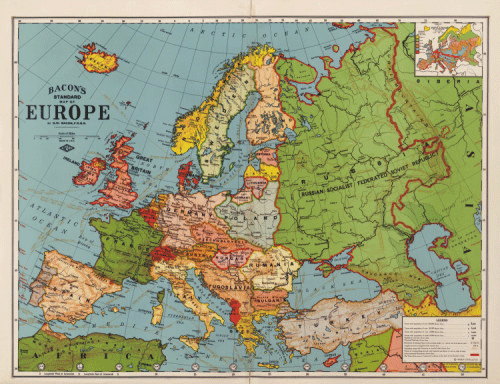


![]()


![]()


LECTURE 9: BUILDING A MOVEMENT
By Paul M. Weyrich and William S. Lind (source)
I can honestly claim to have been one of the godfathers of the existing conservative movement. In some ways, that movement has achieved far more than we ever dreamed it could when we started it in the late 1960s and 1970s. Then, most people thought of conservatism as a marginal force that had been killed and buried with Barry Goldwater’s defeat in 1964. The idea that conservatism could in just a few decades come to represent the American mainstream while liberalism was marginalized would have been unimaginable. Yet that has been the very real achievement of today’s conservative movement.
At the same time, every political movement that succeeds pays a price for its success. In its early stages, as an outsider, it can be true to its agenda. But once it takes power, it inevitably comes to find much of its agenda politically inconvenient. It gets in the way of making deals, gaining more power and collecting money. In time, it ceases to be a real movement and becomes an Establishment.
Regrettably, I have to say this has happened to most of the existing conservative movement, with the exception of the Religious Right. It has gotten in bed with the Republican Party, which provides access, influence and resources to those who will play along. The price has been a “conservatism” that in many respects bears little resemblance to what many of us thought we were fighting for. Most conservative institutions support or are at least silent about a Republican Party government that will not control spending, has driven deficits up to dangerous levels, exports America’s industrial base through “free trade,” promotes ever-larger and more intrusive Federal government and follows a Wilsonian foreign policy. In the face of this abandonment of our old agenda, it is not surprising that it is hard to speak of a conservative “movement” anymore, again excepting the Religious Right. Most of the troops have gone home in disgust.
The old conservative movement is now so compromised that it has little grass-roots credibility. This is the first reason the next conservatism needs a new movement. The existing movement just isn’t real anymore.
But it is not the only reason. The old movement, with a few exceptions like the home-schoolers, was just about politics. As these columns have said over and over, the next conservatism needs to be about much more than politics. Politics of course remain important. Conservatives must remain politically involved and effective, or the Left will mobilize the full power of the state to destroy us and all we believe in.
But we cannot restore our old culture through politics alone. The next conservatism needs not only a new movement, it needs a new kind of movement, a movement of people dedicated to restoring the old ways of living in their own lives and those of their families. The next conservative movement is perhaps best thought of as a community, one devoted to the old conservative virtues of modest living, hard work, prudence (which includes not running after every new thing), thrift, conservation, and living God-centered rather than man-centered lives. If we want to restore our old culture, we have to live by its rules.
There is one other reason why the next conservatism needs a new movement, and it is a promising one. I think the next conservative movement may be able to attract the support of many people who would never join a movement that is an arm of the Republican Party. When I raise the kinds of issues this series of columns has discussed, I find many people saying to me, “I never thought of myself as a conservative but I agree the old ways of life were in many ways better.” It is not just political conservatives who are distressed by the decay of our culture. Lots of people who are not politically involved, or who may think of themselves as moderates or even liberals, are distressed and frightened by the sex and violence that dominates our entertainment, by divorce and illegitimacy, by the fact that school children don’t seem to know anything, and by rampant consumerism and self-centeredness. The next conservative movement could potentially draw some of these people in.
The question then becomes, how do we build a new conservative movement? Building movements has been one my specialties for more than four decades. In my next column, I will offer some suggestions as to how we might accomplish that.
If the next conservatism is to mean anything, it must give birth to a new conservative movement. Ideas on paper do not alone change history. They must be translated into action, and that takes either a movement or a coup. As conservatives, we are not much in favor of coups. So in the next three columns in this series, I want to take a look at the potential for a new conservative movement.
The first question we need to ask is what’s already happening? Here, there is a good deal of encouraging news. As I have said many times in this series, the next conservatism is not just about politics. It is about how we live. If we look around the country, we see a growing number of Americans withdrawing from the mainstream materialist, sexualized, Politically Correct Culture and taking their lives and the lives of their families in different directions. Not all of these different directions fit within the next conservatism, but surprisingly many do.
The most obvious example, and a very important part of the next conservative movement, is home schooling. The public schools are one of the main conditioning mechanisms the cultural Marxists use to undermine our traditional culture. Thanks to home schooling, over a million children are now being saved from that evil conditioning. Most of them are instead getting a traditional, and real, education. They are studying the history and reading the literature of Western, Christian civilization. They are learning real skills, like arithmetic and writing and speaking with correct grammar. They have increasing opportunities to go on after their home schooling to colleges and universities that also offer real educations instead of Political Correctness. All this is an enormous achievement, and it points the way to what the next conservative movement should look like. It is an action that changes the way people live.
Conservatives are comfortable with home schooling because it is a movement we initiated. There are some other movements we did not initiate that I think also fit within the next conservatism. One is the movement to throw out the television, especially in homes with children. We have all seen the active, imaginative children who are raised without television (and computer games) and the sad, brain-dead blobs who have been plopped in front of the TV almost from birth (television now offers programming for two-year olds). Television is the Devil’s baby-sitter; it is an easy way to keep children quiet and “entertained” (“entertainment has become America’s drug of choice), but it does them great long-term damage. “Kill Your Television” did not start as a conservative slogan, but I think it fits quite well into the next conservative movement.
So does the movement to live what I would call “intensive” instead of “extensive” lives. The intensive life uses fewer things and less resources but uses them more thoughtfully and gets more out of them. Examples of the intensive life range from such small actions as having a family vegetable garden, hanging out the wash instead of using a dryer, cycling and walking to run errands instead of driving and taking the train instead of the car to work (you can read on the train) through establishing an organic family farm that sells its products locally (anyone interested in doing this should see Farming Magazine; you can call them at 800-915-0042). All these actions and many more like them are fundamentally conservative, because they represent a return to the way we used to live, in our grandparents’ day. I think there are connections between such actions and the good lives our grandparents led. They also represent a value the current conservative movement seems to have forgotten, namely stewardship. God did not put us here to waste His creation.
Perhaps the way the next conservative movement can begin is to build some bridges among people who, for a variety of reasons and from different backgrounds, are resurrecting the old ways in their own lives. The current culture tells anyone who tries to reject it, “You are all alone. You cannot possibly succeed. There is something wrong with you.” It is hard for individuals to stand against such assaults. But if individuals are tied in with other people who are doing the same sorts of things, resistance to the dominant culture (which is the old counter-culture) becomes easier. There really is strength in numbers.
The next conservative movement is not just a dream. Aspects of it are already happening. In my next column, I will discuss why the existing conservative movement cannot be a successful vehicle for the next conservatism.
In J.R.R. Tolkien’s LORD OF THE RINGS trilogy which is one of the great Christian literary works of the 20th century, the ring of power represents power itself. Tolkien warns that it can never be used for good purposes, because it ultimately distorts whoever uses it to the point where they become evil. Regardless of their original intention, they end up wanting power over everyone else.
These warnings are consistent with what conservatives have always believed. The reason America’s Founding Fathers devised a government of three competing branches was to keep governmental power in check. Conservatives have also sought to keep government small, to keep most governmental power local and the federal government weak. And, they have emphasized tradition, legal precedents and established rights as further means of controlling government power. Rightly, conservatives have realized that the task is not merely to put the right people in power; it is to keep too much power out of anybody’s hands, even the right people’s.
Politics, however, is about acquiring and using power. Does that mean conservatives should not engage in politics? No, because that would allow radicals to take total power and use it to destroy us and everything we believe in. Rather, it means conservatives have to think carefully about how to use power when they obtain it. They have to use it cautiously, prudently, and in measured quantities, just as they would use any other explosive.
There is, I believe, a way the next conservatism can think about political power that can help prevent its abuse. We should use it defensively, not offensively. By using power defensively, I mean we should use political power, success at the ballot box, to prevent government from ramming schemes, ideologies, social engineering and other radical “improvements” down the American people’s throats. There is plenty of this going on, as anyone can see. From “affirmative action” through “No child left behind” to federal regulations that tell us what kind of shower heads and toilets we have to have in our homes, government power intrudes massively into our lives. Defensive use of power seeks to get rid of such intrusions and restore our liberties. In a free American republic, ordinary people would seldom if ever face the power of government, telling them what to do. That was the case in America through most of our history.
Offensive use of power would be if we tried to use the power of government to create the kind of country the next conservatism envisions. That is what our opponents on the Left fear we would do, and I respect that fear (we fear the same of them and with reason). If we did that, we would be using the ring, as Tolkien would put it. The results would not be what we want.
Rather, the way the next conservatism should work to restore America is from the bottom up, from the grass roots, not from the top down. Real restoration comes when free individuals decide to change how they live their own lives. This is what the Christian call to repentance means. Repentance cannot be forced. It can only come from a change of mind and heart, which is brought about most powerfully by example, by seeing how we, as conservatives, live.
That puts a heavy burden on us, a heavier burden than just winning elections. By living our lives according to the old rules and in the old, honest, modest ways of our forefathers, preferring work over entertainment, our neighbors’ well-being over profits and production over consumption, we can set the right example. We can demonstrate that lives lived this way are richer, fuller, more rewarding than lives devoted to instant gratification and conspicuous consumption, to ego, vanity and stuff. The power of example is safe power, because it does not coerce. Rather, it leads and inspires.
Again, this does not mean the next conservatism should avoid politics. That would lead to our destruction. Rather, it limits what we expect from politics, and points to a harder, slower, but also safer and surer road to restoring America. Think locally, act locally, and provide a local example of life lived well: that is how the Christian church grew amidst a decaying Roman Empire. It is also how the next conservatism can restore an American republic as a falling America Empire collapses around us.
BUILDING IT
In the last two essays, I have argued that the next conservatism needs a new conservative movement. In my more than forty years in Washington, I have been involved in building more than one movement. There is a political mechanics involved that works pretty much the same way for any movement. Here, I want to share with you briefly how that mechanics of movement-building works.
The first step is to identify a target list. Who do you want to reach? For the most part, your target list will be people and organizations who already share some of your views, and who are likely to be interested in what your new movement wants to accomplish.
Next, you need to send out field teams to do audits. You want to audit each potential ally or target group on its own ground. Your audit asks questions such as:
o What local organizations are effective?
o What is their home ground?
o Who do they reach?
o How do they communicate?
o Who are their most effective leaders?
The audit is your map; it tells you the lay of the land, so you know who to talk to, who is real and who isn’t.
Then you need to identify your own leader. It has to be someone other people can look to as a leader, and it has to be someone who is willing to take risks. You cannot build a new movement just by playing it safe all the time. As Napoleon said, if you are going to make an omelet, you have to break some eggs.
The next step is to get your leader together with the people and organizations your audit has identified as potential allies. He needs to have a written statement of your new movement’s goals. For the most part, anyone who will sign on to those goals can be part of your movement. There will be cases, however, where your leader has to recognize that some groups may be unacceptable to other groups your movement needs more.
Then comes the single most important element. As your coalition of interested groups and individuals grows, you must maintain constant communication with them. They must always be receiving something new and interesting from you, including not only information but also activities in which they can join. Constant communication is the lifeblood of any movement, and if it is not maintained, the movement will die. Fortunately, thanks to the internet and other new technologies, it is technically much easier and much less expensive to maintain constant communication today than it was when I began in conservative politics in the 1960s.
While your new movement’s leadership must always be open to communications from your troops in the field, it is a mistake to think any movement will just “happen” on a bottom-up basis. For the most part, your troops will be asking you, “What should we do?” Your leadership must be pro-active in coming up with things for them to do, things that will hold their interest while advancing your movement’s cause.
Again, this is a simplified version of the mechanics of movement-building, but it touches on all the basics. Remember, no matter how good your message, without the right mechanics it will go nowhere.
With a correct, proven approach to political mechanics, I have no question that it is possible to build a new movement around the next conservatism. If I were twenty years younger, I would do it myself. In fact, I would enjoy doing it. Nothing has been more rewarding in my career than working with the many good people who make up the conservative grass roots.
As it is, building the new movement is a task I will have to leave to others to lead. But I do stand ready to advise and assist them with all I have learned over more than four decades of building conservative movements. Creating the next conservative movement is something that needs to be done and can be done.
This is the fiftieth essay in our Next Conservatism series and it is a good point to look back at the road we have traveled. When we began this series we were thinking we might write a dozen essays on where the conservative movement needs to go. Now we are at fifty essays and still counting; we have no intention of stopping here. Why not? Mainly because of the overwhelming response from people who see the need for something new if conservatism is to deal with the problems of the twenty-first century.
The Next Conservatism is not yet a movement but it may be on its way to becoming one. The February 12 issue of The American Conservative carried the Next Conservatism as its cover story in a piece we co-authored. Three other leading conservative thinkers offered their comments in the same issue. None was really hostile. We are also getting growing interest in the Next Conservatism from Capitol Hill. Senators and Members of Congress are coming to see that the supposed conservatism of the Republican Party is inadequate both intellectually and politically. It neither motivates the grassroots nor comes to grips with the problems facing our country. We are now talking with a leading conservative publisher about writing a book on the Next Conservatism. Despite all the new media, at a certain point a movement needs a book. Nothing else works for laying out a program and a plan. Somehow, we find the continued importance of books comforting.
Most important and encouraging to us has been the response of the conservative grassroots. People are sick of the games they see being played in Washington. They know that Washington is not doing what needs to be done to govern our country. Spending is still out of control with vast budget and trade deficits and a pyramid of public and private debt that could create a depression if it crashes. Uncontrolled immigration is flooding our country with people whose culture and traditions are alien to our own. Some businesses along the border accept pesos as well as dollars in payment. Our economy may be going great for big international corporations but we continue to hemorrhage manufacturing jobs at a fearful rate thanks to a policy of mindless free trade. How can conservatives talk about being pro-family if we do not protect the kind of good-paying jobs breadwinners need to support a family?
Looming over everything is the disaster of Iraq. Woodrow Wilson’s foreign policy, resurrected by a Republican President, has again brought us nothing but grief just as it did under Wilson. Conservatives in Washington may have forgotten the wisdom of Senator Robert A. Taft, but Americans in the heartland have not. The real conservatives out there know we should never go to war except to defend America’s own national security and the most significant threat to that security lies on our border with Mexico where the Bush Administration’s Justice Department is prosecuting Border Patrol agents for shooting back.
Grassroots conservatives have surprised us in some of their reactions to our essays. We did not think many Americans would share our interest in agrarianism, in bringing back the family farm as a way of life many families could enjoy. We received tremendous response to that idea. It seems many people remember farm life as a good one, especially for children.
We are not sure how people would react to our idea of retro-culture, of recognizing that life in the past was better in many ways than life today and trying to bring some of the old ways back. Again, we have gotten many positive responses. It seems the Modernizers who endlessly warn that we can’t go back have not bamboozled everyone. Memory, especially memories of how good life was in the 1950s, can still overcome ideology.
Most encouragingly, grassroots conservatives have told us that they, too, are disgusted by a conservatism that is defined as nothing more than “I’ve got mine.” America’s coastal elites seem to sing endlessly that old song called “I Want What I Want When I Want It.” The grassroots conservatives of America’s heartland reply with a hymn that begins “Turn Back, O Man, and Forswear Thy Foolish Ways.” It is the heartland and not the elites who are in touch with reality.
So this fiftieth essay is a long way from marking the end of the Next Conservatism series. In fact, we would like to open it up to more authors. If you have a topic you think is important to the Next Conservatism agenda please contact us. We will be happy to consider an essay from you. We don’t have all the answers or all the questions, for that matter. Building the Next Conservatism and the new conservative movement is work for many hands. Thanks to the interest and support of the good people who make up the conservative grassroots we are confident that this work will go forward.
READING FOR THE NEXT LECTURE



![]()


![]()

